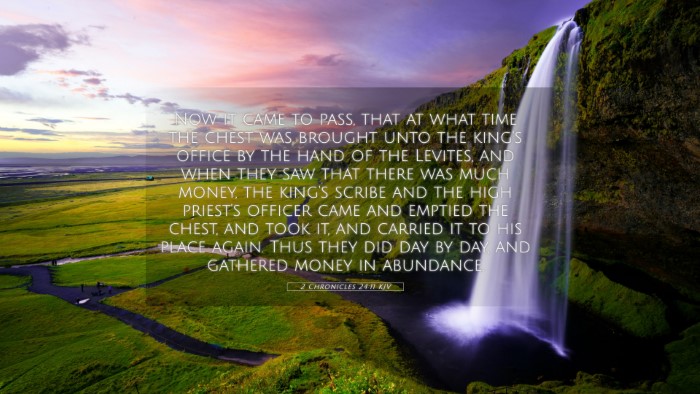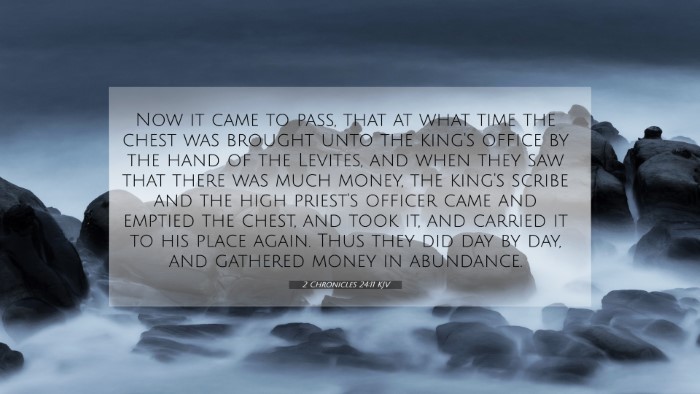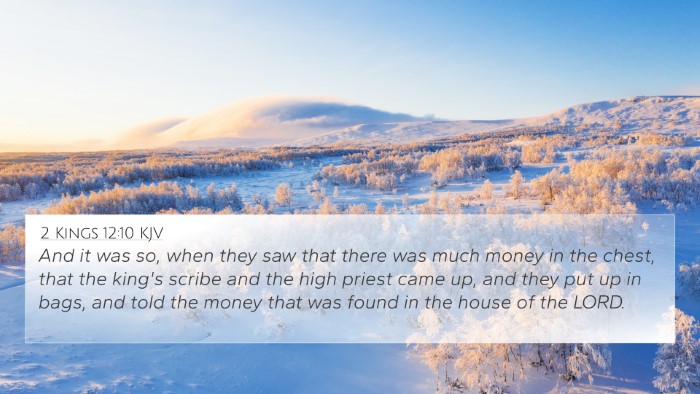2 Chronicles 24:11 states: "And it came to pass, that at what time the chest was brought unto the king's office by the hand of the Levites, and when they saw that there was much money, the king's scribe and the high priest's officer came and they emptied the chest, and took it, and carried it to his place again. Thus they did day by day, and gathered money in abundance."
This scripture presents a significant moment in the history of Judah, illustrating the organized efforts to restore the temple and the spiritual practices of the people. The actions described shed light on the fiscal responsibility required for temple upkeep and the dedication of leaders in ensuring that the Lord’s house was properly maintained.
Meaning and Interpretation
The verse highlights several themes which can be elaborated upon using public domain commentaries.
-
Matthew Henry Commentary:
Matthew Henry emphasizes the importance of diligent stewardship in managing the funds for God's work. He notes that the Levites were entrusted with the collection and the management of the resources dedicated to the temple, underscoring the importance of integrity in ministry. The continuous effort depicted here indicates a significant commitment to ensure that the temple and its operations were well-funded and that worship could continue without hindrance.
-
Albert Barnes Commentary:
Albert Barnes provides insight into the procedural nature of the collections, illustrating the structure put in place to support the priestly class and temple activities. He points out the contrast between the public zeal for giving to the temple versus any previous negligence, providing a reflection on the people's return to faithfulness and the importance of communal responsibility in worship.
-
Adam Clarke Commentary:
Adam Clarke gives a description of the physical act of giving and its spiritual implications. He comments on the communal joy that often accompanies such contributions, emphasizing that financial support of the temple is seen as an act of worship, showcasing the connection between material resources and spiritual devotion. Clarke’s insights encourage believers to understand that support for God’s house is a way to express gratitude for all God has provided.
Key Themes and Takeaways
-
Stewardship: The collection of funds highlights the significance of being good stewards of what God provides. The leaders' roles in collecting and managing these resources serve as a model for how believers today should handle their resources.
-
Community Effort: This verse illustrates how the entire community rallied around a common cause—the restoration of the temple, which serves as a reminder of the importance of unity in faith.
-
Faithfulness: The receipt of money signifies a return to practices that honor God, demonstrating a community's desire to restore their relationship with Him.
-
Worship and Giving: The act of giving to the temple serves as a reminder that worship is not just about spiritual activity but also involves physical, tangible expressions of love and dedication to God.
Related Bible Verse Cross-References
- 2 Kings 12:4-12 – This passage recounts the same event of collecting funds for the temple repairs, establishing a direct cross-reference and giving further context.
- Exodus 35:5 – In this scripture, offerings are called for the construction of the tabernacle, reinforcing the biblical principle of giving for the work of God.
- 1 Chronicles 29:9-14 – This verse addresses the joy of giving from a willing heart, showcasing how giving is tied to spiritual enthusiasm.
- Malachi 3:10 – A call to bring the whole tithe into the storehouse, linking the concept of providing for God's work to the blessings that flow as a result.
- Matthew 6:21 – Jesus teaches that where your treasure is, there your heart will be also, affirming the spiritual significance of giving.
- Acts 2:44-45 – Early Christians shared all their possessions, showing the communal nature of supporting each other and their spiritual endeavors.
- 2 Corinthians 9:7 – A New Testament perspective on giving, emphasizing that each person should give what they have decided in their heart, not reluctantly or under compulsion.
Conclusion
The analysis of 2 Chronicles 24:11 through the lens of various public domain commentaries illuminates key themes of stewardship and collective responsibility in worship. It provides multiple layers of meaning that connect believers not only to historical practices but also to the spiritual implications of their actions in relation to God’s work. Through cross-referencing biblical texts, one can draw deeper understandings of these themes and apply them to personal faith and church life today.




